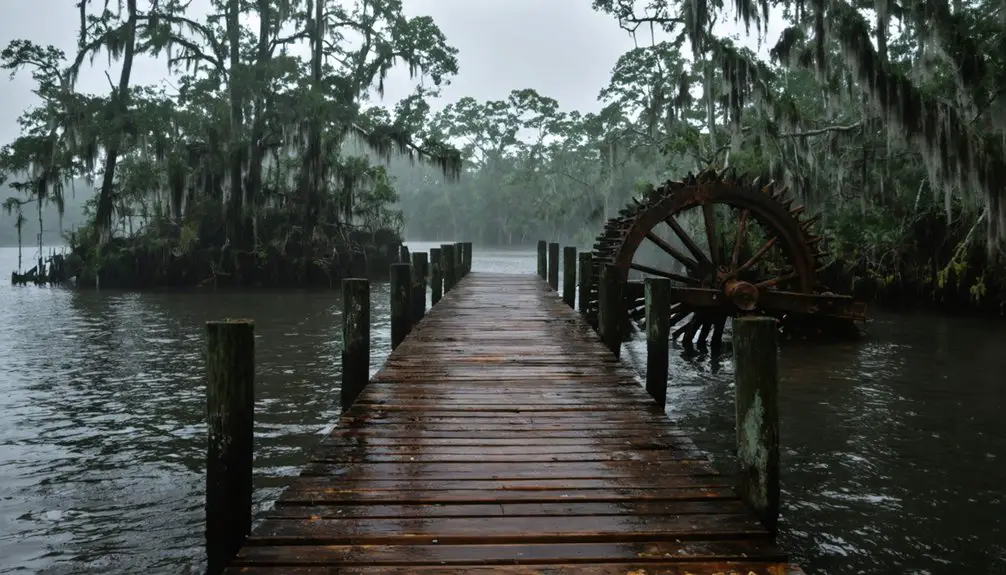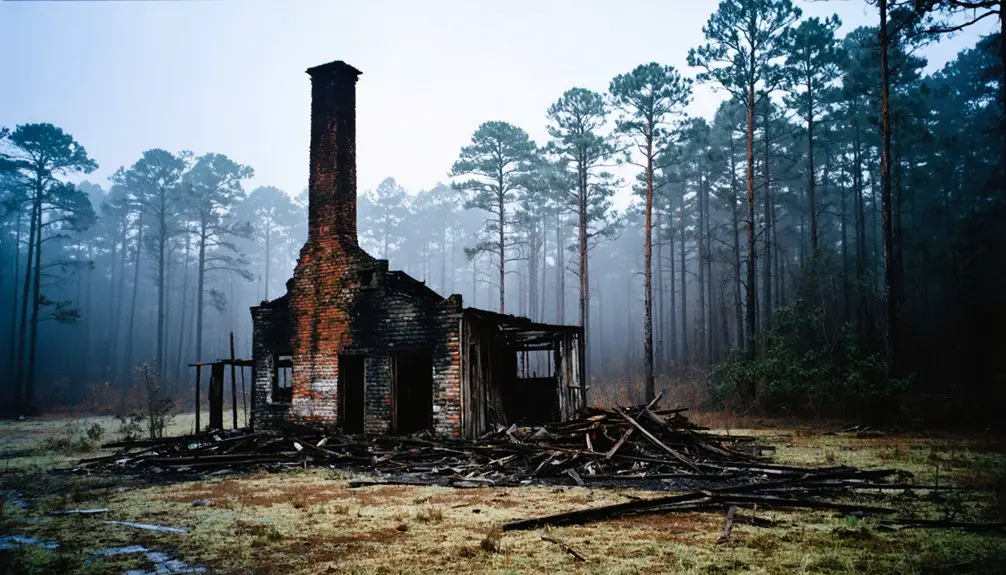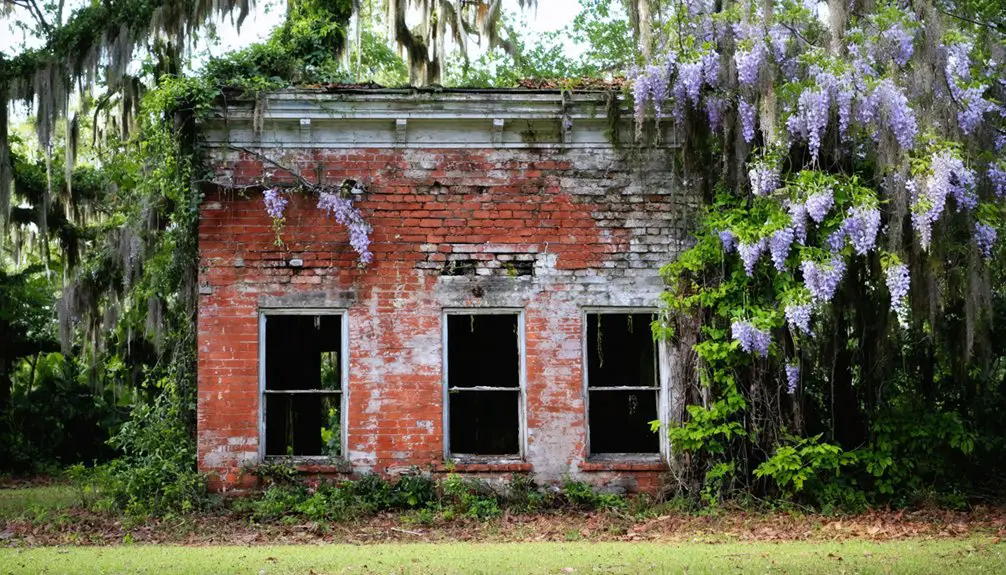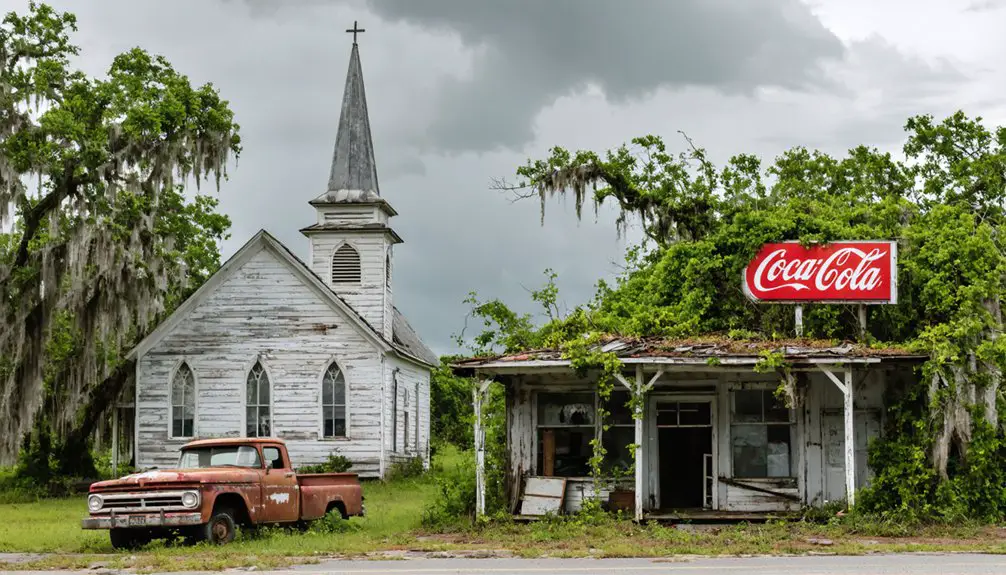You’ll find the remnants of Troy, Florida along the Suwannee River, where a bustling settlement of 500 residents once thrived from 1856 to 1899. After relocating from Old Troy due to flooding, New Troy emerged as an essential river commerce hub with steamboat traffic, cotton gins, and sawmills. Natural disasters, including the devastating courthouse fire of 1892, led to the town’s abandonment. Today, nature has reclaimed the site, but scattered artifacts tell a deeper story.
Key Takeaways
- Troy was a thriving Florida town along the Suwannee River that peaked at 500 residents before becoming abandoned due to disasters.
- The town relocated from Old Troy to New Troy after an 1856 fire, demonstrating early resilience before its ultimate decline.
- A devastating courthouse fire in 1892 marked the beginning of Troy’s end, leading to mass migration to nearby Mayo.
- The town’s infrastructure included steamboat services, ferry crossings, cotton gins, and sawmills supporting regional river commerce.
- Today, Troy’s remains are reclaimed by Florida wilderness, with only scattered ruins, stone walls, and cemetery remnants visible.
The Rise of Old Troy on the Suwannee River
While many Florida settlements flourished along waterways in the early to mid-1800s, Old Troy emerged as a particularly strategic location on the Suwannee River.
You’ll find that the town’s position capitalized on the rich riverine ecology, enabling settlers to establish a thriving community focused on agriculture, turpentine production, and river trade. The important steamship Madison served the community as a floating mail service and trading post.
As you explore Old Troy’s origins, you’ll discover how the pioneer lifestyle shaped its development.
The settlement quickly grew to support essential infrastructure, including a cotton gin and sawmill that processed the region’s natural resources. The town became a hub for transporting vegetables and oranges via steamboat service.
By establishing itself as a crucial steamboat stop, the town connected local farmers and producers to broader markets.
At its peak, you’d have found a bustling community of 500 residents before a devastating fire in 1856 marked the beginning of its decline.
Relocation and Birth of New Troy
After Old Troy’s devastating fire in 1856, the resilient community established New Troy approximately a quarter mile from the original settlement, strategically positioning it away from flood-prone areas.
This act of community resilience demonstrated the settlers’ determination to preserve their way of life and commercial interests along the Suwannee River.
Just as the ancient city of Troy showcased multiple layers rebuilt after destruction, New Troy exemplified the same spirit of reconstruction and renewal.
The historical significance of New Troy’s founding became official when the post office opened on August 25, 1860.
The establishment of New Troy’s post office in August 1860 marked a pivotal moment in legitimizing this resilient community’s fresh start.
Though briefly renamed McIntosh in 1861, the settlement maintained its identity as New Troy by 1871.
You’ll find that the town’s early development reflected careful planning, with residents choosing a location that would support their agricultural and trading activities while protecting them from the environmental challenges that had plagued Old Troy.
Similar to the original Troy silver mining town that operated until the mid-1960s, New Troy continued to evolve and adapt to changing times.
Life Along the River: Commerce and Community
You’d find New Troy’s bustling riverside hub filled with steamboats transporting cotton, turpentine, and lumber products through the region’s essential trade networks during the 1870s.
The town’s strategic location along the Suwannee River supported a population of 500 residents, who relied on the ferry service to Branford and the river’s commercial opportunities for their livelihoods. Much like the early trade posts at Cuffey Town, residents engaged in active commerce along the waterways. Like many Florida settlements, New Troy experienced the typical boom-bust cycles that characterized development in the state.
A vibrant community life emerged around these maritime activities, with two newspapers, multiple churches, and various steam-powered industries serving the town’s economic and social needs.
River Trade Networks
Situated nine miles upriver from Branford, Troy’s strategic position on the Suwannee River established it as a significant hub within Florida’s 19th-century river trade networks.
You’d find steamboats and flatboats regularly traversing these waters, carrying timber, agricultural products, and necessary supplies between settlements. The river transport system created economic interdependence among communities, with Troy’s boat landing serving as an essential connection point.
The town’s commercial infrastructure included docks and storage facilities, while markets and trading posts emerged to serve both river travelers and local producers. Much like the historic Chelsea Piers terminals, Troy’s waterfront facilities were crucial for passenger and cargo operations.
You could access services ranging from boat repairs to trade brokerage, all important for maintaining the flow of commerce. Despite Civil War disruptions that led to Troy’s burning, the community’s determination to preserve trade records reflected the river network’s critical importance to regional prosperity.
Daily Life Activities
Life along the Suwannee River in Troy centered around a vibrant mix of commercial and social activities that defined daily existence.
You’d find your daily routines shaped by the rhythms of steamboat arrivals and the seasonal demands of agriculture. Community gatherings at the Baptist and Methodist churches served as focal points for social life, while the two general stores offered both essential goods and places to connect with neighbors.
If you worked in logging or turpentine production, you’d likely rely on company stores for necessities, though this system often limited your economic freedom through scrip payments. The company store system proved especially detrimental to workers’ financial independence, as documented in High Coria’s industrial history.
Your schedule would revolve around industrial operations, with the ever-present risk of fires from steam boilers. The boarding house, post office, and ferry service formed significant touchpoints in Troy’s interconnected community life.
Transportation Hub Evolution
The bustling river trade transformed Troy into a key transportation nexus along the Suwannee River before 1995, when boat access served as the primary connection to the outside world.
You’d find riverboat innovation at its finest with vessels like the *Madison*, specifically designed with a shallow draft to navigate the river’s unpredictable water levels. River transportation proved far more efficient than overland routes for moving goods during this period.
Trade logistics centered around twice-monthly mail runs and mobile trading posts, where you could exchange agricultural goods for manufactured items. The floating country store concept proved highly successful as the Madison traded for local venison, hides and honey.
The *Madison’s* distinctive ten-mile-range whistle announced essential commerce opportunities to isolated settlements. This river-based network proved so important that Confederate forces later adapted commercial vessels for military purposes, with Captain James Tucker’s conversion of riverboats into makeshift gunboats highlighting their strategic value.
Troy’s position helped connect remote communities to broader trade networks until the Civil War disrupted operations.
Transportation Hub: Steamboats and Ferry Service

Before modern roads existed, you could access Troy primarily through boat docks and ferry services.
River navigation posed significant challenges – the Bertha Lee once spent 52 days cutting channels by hand to traverse a typically short stretch.
These watercraft transported everything from livestock to honey, supporting local economies and enabling trade that’d otherwise be impossible, while simultaneously serving Confederate interests during the Civil War.
Daily Life in 19th Century Troy
You’d find Troy’s bustling riverfront alive with steamboat traffic as workers loaded cotton, turpentine, and oranges for export while unloading essential supplies for the town’s two general stores.
Church services at the Baptist and Methodist buildings anchored the community’s social calendar, with circuit-riding preachers delivering sermons to congregations of frontier families.
Beyond religious gatherings, you’d see residents congregating at the courthouse and general stores, where they’d exchange news and conduct business until the courthouse’s devastating fire in 1892.
River Trade Activities
During the bustling 19th century, river trade dominated daily life in Troy, Florida, where steamboats served as essential arteries for commerce and transportation. You’d find shallow-draft vessels traversing the challenging waterways, maneuvering through shoals and oyster bars while carrying crucial cargo like citrus, lumber, and cotton northward.
The river trade fostered complex economic interactions between merchants, Indigenous peoples, and settlers. You’d see crews working tirelessly to load and unload freight at the docks, while local laborers managed tight schedules amid unpredictable weather.
The bustling ports connected Troy’s agricultural products to national markets, with over 150 steamships operating throughout Florida by century’s end. This network supported ancillary industries like shipbuilding and repair, while newspaper listings of boat schedules kept the community’s daily rhythms flowing.
Church and Social Gatherings
As the spiritual and social cornerstone of Troy, Florida, churches shaped the fabric of 19th-century daily life through their dual role as religious sanctuaries and community hubs.
You’d find the Old Troy Church, built in 1837 by Episcopalians and later owned by Methodists, alongside a Baptist church, serving as crucial gathering spots where you could connect with neighbors and participate in town affairs.
Beyond Sunday services, you’d experience a rich tapestry of church events including fundraisers, social dinners, and holiday celebrations.
These community gatherings weren’t just about worship – they provided essential platforms for education, communication, and mutual support.
Through the churches’ influence, you’d find yourself part of a tight-knit social network that helped Troy’s residents weather hardships and maintain strong community bonds.
Natural Disasters and Historical Fires

While many ghost towns fade slowly into obscurity, Troy’s dramatic decline can be traced to a series of devastating fires and natural disasters throughout the mid-to-late 1800s.
You’ll find the town’s vulnerability stemmed from its location in the Suwannee River floodplain, where wooden structures and limited fire safety measures left it exposed to catastrophe. The original settlement burned in 1856, forcing relocation to New Troy.
Subsequent fires, including the pivotal courthouse blaze of December 31, 1892, proved insurmountable. Without modern disaster preparedness systems, the town couldn’t recover from repeated flooding and fires that destroyed critical infrastructure.
These events culminated in the courthouse’s relocation to Mayo, effectively ending Troy’s role as a government center and hastening its abandonment.
The Great Migration to Mayo
You’ll find that the courthouse fire marked a pivotal economic turning point, as the destruction of essential records and infrastructure severely disrupted Troy’s commercial activities.
The resulting financial instability triggered a significant population shift, with many residents relocating to the growing town of Mayo in search of better prospects.
This exodus fundamentally altered Troy’s community structure, transforming it from a bustling town into a sparsely populated settlement.
Courthouse Fire’s Economic Impact
The 1892 courthouse fire in Troy triggered a devastating chain of economic consequences that would permanently alter Lafayette County’s landscape. The destruction of crucial records created widespread legal instability, disrupting property transactions and business operations throughout the region.
You’ll find the economic disruption manifested in three key ways:
- Property owners faced uncertainty over land titles, making it difficult to sell or develop their holdings.
- Local businesses struggled with delayed legal resolutions and contract disputes, leading to financial losses.
- County resources were strained by rebuilding costs and investigation expenses, limiting public services.
This economic turmoil contributed to Troy’s eventual abandonment as residents and businesses sought more stable conditions in nearby Mayo, where intact infrastructure and reliable governance promised better opportunities.
Population Exodus Reshapes Community
Beyond the economic upheaval caused by the courthouse fire, a dramatic reshaping of Lafayette County’s population followed in 1893.
You’ll find that Troy’s residents, faced with diminishing opportunities and the loss of administrative functions, began a steady migration toward Mayo, testing the limits of community resilience.
As Mayo gained prominence as the county’s only incorporated municipality, you’d see how the exodus transformed Troy into a ghost town.
Government workers, business owners, and families seeking stability relocated, fundamentally altering the region’s demographic landscape.
The historical legacy of this migration reveals how administrative decisions can trigger profound social change.
Mayo’s subsequent growth, supported by infrastructure development and economic diversification, contrasted sharply with Troy’s decline, where abandoned properties and isolated residents marked the end of an era.
Vanishing Buildings and Reclaimed Wilderness

Once thriving with human activity, Troy’s buildings have steadily vanished into Florida’s wilderness through both deliberate dismantling and natural reclamation.
You’ll find these vanishing landscapes most evident in the systematic removal of structures for their materials, while nature aggressively reclaims former streets and homesteads. The wildlife resurgence has transformed former residential areas into vibrant ecosystems.
- Building remnants scatter the forest floor – from partial stone walls to displaced bricks and iron fixtures
- Former roadbeds and pathways have surrendered to vegetation, with only faint traces remaining
- Historic landmarks like old smokestacks and cemeteries stand as silent witnesses amid the expanding hardwood forest
The shift from bustling river town to wilderness showcases nature’s persistent power to erase human presence, leaving only scattered ruins as evidence of Troy’s existence.
Cemetery Stories and Surviving Landmarks
Standing as one of Troy’s last tangible links to its past, the town cemetery contains weathered tombstones dating primarily to the late 1800s, offering poignant glimpses into the community’s former life.
You’ll find grave markers of infants and young children, their dates revealing the harsh realities of frontier living. While cemetery preservation efforts haven’t prevented nature’s steady reclamation, the site remains accessible to those seeking historical connections.
Beyond the cemetery’s boundaries, you can trace old pathways through the wilderness where Troy’s buildings once stood.
Faint trails wind through overgrown brush, marking where Troy’s streets and structures once carved paths through untamed land.
Though the courthouse’s burning in 1892 hastened the town’s decline, careful observers can still spot fragments of porcelain and wooden debris from former homesteads.
These scattered remnants, along with local ghost stories, keep Troy’s memory alive for modern explorers.
Historical Impact on Florida’s River Communities
During its peak in the late 19th century, Troy played an essential role in shaping Florida’s river commerce as a bustling hub along the Suwannee River.
You’ll find evidence of river resilience in the town’s ability to adapt, moving from Old Troy to New Troy to escape flooding while maintaining its economic vigor through steamboat traffic until 1899.
The town’s economic shifts reflected broader changes in Florida’s river communities:
- Developed diverse infrastructure including cotton gins, sawmills, and general stores that supported regional trade
- Served as a significant transportation nexus through its ferry service to Branford until 1917
- Facilitated the movement of important goods like cotton, turpentine, vegetables, and oranges throughout the region
This river-based economy sustained a population of 500 until modern transportation methods eventually rendered the waterway less essential.
Frequently Asked Questions
Are There Any Documented Ghost Sightings or Paranormal Activities in Troy?
You won’t find officially documented ghost encounters or paranormal investigations in Troy. While local folklore mentions ghostly presences, there’s no verified evidence of supernatural activity in historical or modern records.
What Indigenous Native American Tribes Originally Inhabited the Troy Area?
Like trackers following ancient paths, you’d find the Seminole people were the main tribe in Troy’s area, with Creek-related groups present earlier, leaving tribal artifacts that tell their native culture’s story.
How Did Residents Receive Medical Care in Troy’s Early Days?
You’d receive healthcare primarily at Old Troy Hospital, staffed by Dr. John Thorn and Sisters of Charity. The medical facilities offered surgical services, while the nursing school established in 1895 supported local healthcare practices.
What Happened to Troy’s Residents After the Town Was Abandoned?
After Troy’s population dropped 90% by 1913, you’d find Troy residents relocating to Mayo following the courthouse move, while others dispersed to nearby towns seeking economic opportunities after Troy’s abandonment.
Were There Any Notable Crimes or Outlaws Associated With Troy?
You won’t find any infamous crimes or Troy outlaws in historical records. The town’s decline stemmed from natural disasters and economic shifts rather than criminal activity or lawlessness.
References
- https://www.youtube.com/watch?v=SfNW9rjRUbQ
- https://pinintheatlas.com/travel-blogs/troy-ghost-town/
- https://en.wikipedia.org/wiki/Troy
- http://files.usgwarchives.net/fl/lafayette/history/carltroy.txt
- https://www.youtube.com/watch?v=aoel0MrTQ_k
- https://www.floridastateparks.org/parks-and-trails/troy-spring-state-park/history
- https://www.historynewsnetwork.org/article/suwannee-steamboat-skeleton-is-it-the-madison-scut
- https://stars.library.ucf.edu/cgi/viewcontent.cgi?article=3029&context=fhq
- https://www.paddleflorida.org/paddler-profiles/suwannee-river
- https://patchproflorida.com/blog/the-fascinating-history-of-floridas-ghost-towns/



